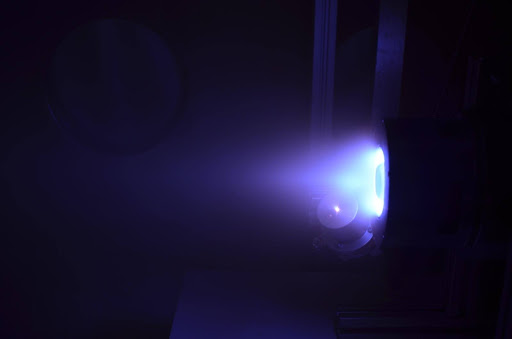Performance Evaluation of Pulsar Fusion’s 500W Hall Effect Thruster with Integrated LaB6 Cathode Using Krypton Propellant
Author: Pulsar Fusion UK Ltd.
Affiliation: Pulsar Fusion, Bletchley, UK
Abstract
This whitepaper presents an analysis of experimental performance data from Pulsar Fusion’s 500W Hall Effect Thruster (HET), designated as the LeoBear model, equipped with an in-house LaB6 cathode. The thruster was tested using krypton (Kr) as the propellant across a range of discharge voltages (200–325 V) and anode flow rates (18–28 sccm), achieving power levels from 296 W to 832 W. Key metrics evaluated include thrust, specific impulse (Isp), anode efficiency, and total efficiency. Thermal data from operational runs indicate manageable temperature profiles, with inner magnet temperatures reaching up to 225.4C. The thruster demonstrates reliable startup and operation at low power (296 W), with potential for higher Isp using xenon (Xe) propellant. Maximum tested power was 825 W, limited by apparatus constraints. Results suggest the LeoBear HET offers promising efficiency and thrust scalability for small satellite propulsion applications, with recommendations for further optimization.
1. Introduction
Hall Effect Thrusters (HETs) are a mature class of electric propulsion technology, widely implemented for orbital manoeuvres, station-keeping, and deep-space missions due to their combination of high specific impulse and moderate thrust-to-power ratios. Xenon is traditionally used as the propellant owing to its high atomic mass and low ionisation potential, but rising interest in krypton offers cost and supply-chain advantages, albeit with lower theoretical Isp.
The Pulsar Fusion LeoBear 500 W HET integrates a LaB₆ cathode, selected for its high electron emissivity, thermal robustness, and potential for extended operational lifetimes relative to conventional hollow cathodes. This paper presents a performance characterisation of the LeoBear with krypton propellant under laboratory vacuum conditions, with the aim of assessing operational stability, performance scaling, and thermal behaviour.
2. Experimental Setup
Testing was performed at Pulsar Fusion’s vacuum facility. The LeoBear HET was mounted on a calibrated thrust stand with a coefficient of 0.000677 mm/mN and offset of 0.000813 mm. Displacement was measured via laser interferometry. The thruster is not BoL and has accumulated approximately 100 hours of operational runtime prior to this data set.
Krypton was delivered at anode flow rates between 18–28 sccm (1.12–1.74 mg/s) and cathode flow at 8 sccm (0.50 mg/s). Discharge voltages ranged from 200–325 V with currents adjusted to achieve target powers. Keeper currents of 1.5–2.95 A were used for ignition. Inner and outer magnet circuits operated at 1.05–1.14 A and 3.5–4.5 V.
Thermocouples were mounted on the inner magnet and thruster base, with temperatures logged at 1 Hz. Performance calculations followed standard HET diagnostic methods.
3. Results & Discussion
3.1 Data Points






3.2 Performance Metrics
The thruster was tested across 24 distinct operating points, grouped by anode flow rates. Table 1 summarizes key results, averaged where multiple points exist at similar conditions.
At nominal 500W operation (e.g., 300 V, 1.72 A, 20 sccm), thrust reached 18.4 mN with Isp of 1502 s and anode efficiency of 26.2%. Peak anode efficiency (44.8%) occurred at 325 V, 2.56 A, and 28 sccm, yielding 36.1 mN thrust and 2108 s Isp. Total efficiency peaked at 31.8%, indicating room for optimization in power processing losses.
Thrust scales linearly with power (correlation coefficient r ≈ 0.95), as expected for HETs. Isp increases with voltage due to higher ion acceleration, reaching >2000 s at higher powers. Efficiencies improve at elevated flow rates and voltages, attributable to better plasma confinement and reduced wall losses.
3.3 Low-Power Startup and Operation
The thruster demonstrated reliable ignition and stable operation at 296 W (200 V, 1.48 A, 18 sccm anode flow), producing 13.2 mN thrust and 1199 s Isp. Anode efficiency was 26.2%, comparable to higher-power points. This confirms the LeoBear’s suitability for power-constrained missions, such as small satellite deployments. The LaB6 cathode’s low work function facilitated startup with keeper currents as low as 2.21 A.
3.4 High-Power Scaling
Maximum tested power was 832 W (325 V, 2.56 A, 28 sccm), limited by Chamber 3 setup apparatus. Engineering assessments suggest short-duration operation beyond 825 W will be feasible with Chamber 3’s feedthrough upgrades. Thrust at this point was 36.1 mN, with Isp of 2108 s—among the highest for Kr-based HETs in this power class.
3.5 Thermal Performance
Thermal data from a representative run show inner magnet temperatures stabilizing at 176°C after ~2 hours of operation, with thruster base temperatures at 63°C. Temperature rise was gradual (initially ~24°C ambient), indicating effective radiative cooling. No overheating was observed below 500 W, but at higher powers, thermal limits on magnets (e.g., Curie point risks) warrant monitoring. Data suggest the design tolerates continuous operation up to 800 W without active cooling.
3.6 Propellant Considerations: Krypton vs. Xenon
All tests used krypton, yielding Isp values 10–20% lower than typical Xe-based HETs due to krypton’s lower mass. However, engineering feedback indicates potential Isp gains with xenon, possibly exceeding 2500 s at equivalent conditions, based on ionization efficiency models. Kr’s lower cost (∼$0.5/g vs. $2/g for Xe) makes it attractive for cost-sensitive applications, though Xe may be preferred for missions requiring maximal delta-V.
3.7 Limitations and Uncertainties
Variability in keeper voltages (16–35 V) suggests cathode optimization could reduce power overhead. Efficiencies below 50% highlight losses from beam divergence and neutral ingestion. Thermal data, while informative, may not fully align with performance runs due to date discrepancies.
4. Conclusions
Pulsar Fusion’s LeoBear 500W HET with LaB6 cathode exhibits robust performance across 296–832 W, with thrust up to 36 mN, Isp up to 2108 s, and efficiencies up to 44.8% using krypton. Low-power startup at 296 W and potential for short-term high-power operation position it as a versatile option for small spacecraft. Transitioning to xenon could enhance Isp, while future tests are expected to demonstrate sustained >800 W operation. Future work should focus on lifetime testing, plume characterization, and Xe validation to advance commercialization.
Acknowledgments
Data provided by Pulsar Fusion engineering team. Analysis conducted using provided datasets from August 6, 2025.
Pulsar Fusion Technical Report | Code: PF-LEOBEAR-KR-2025-V2 LAB6
